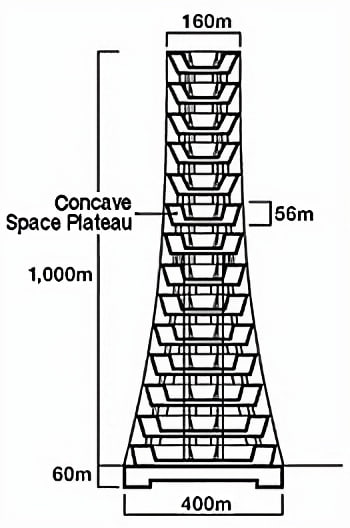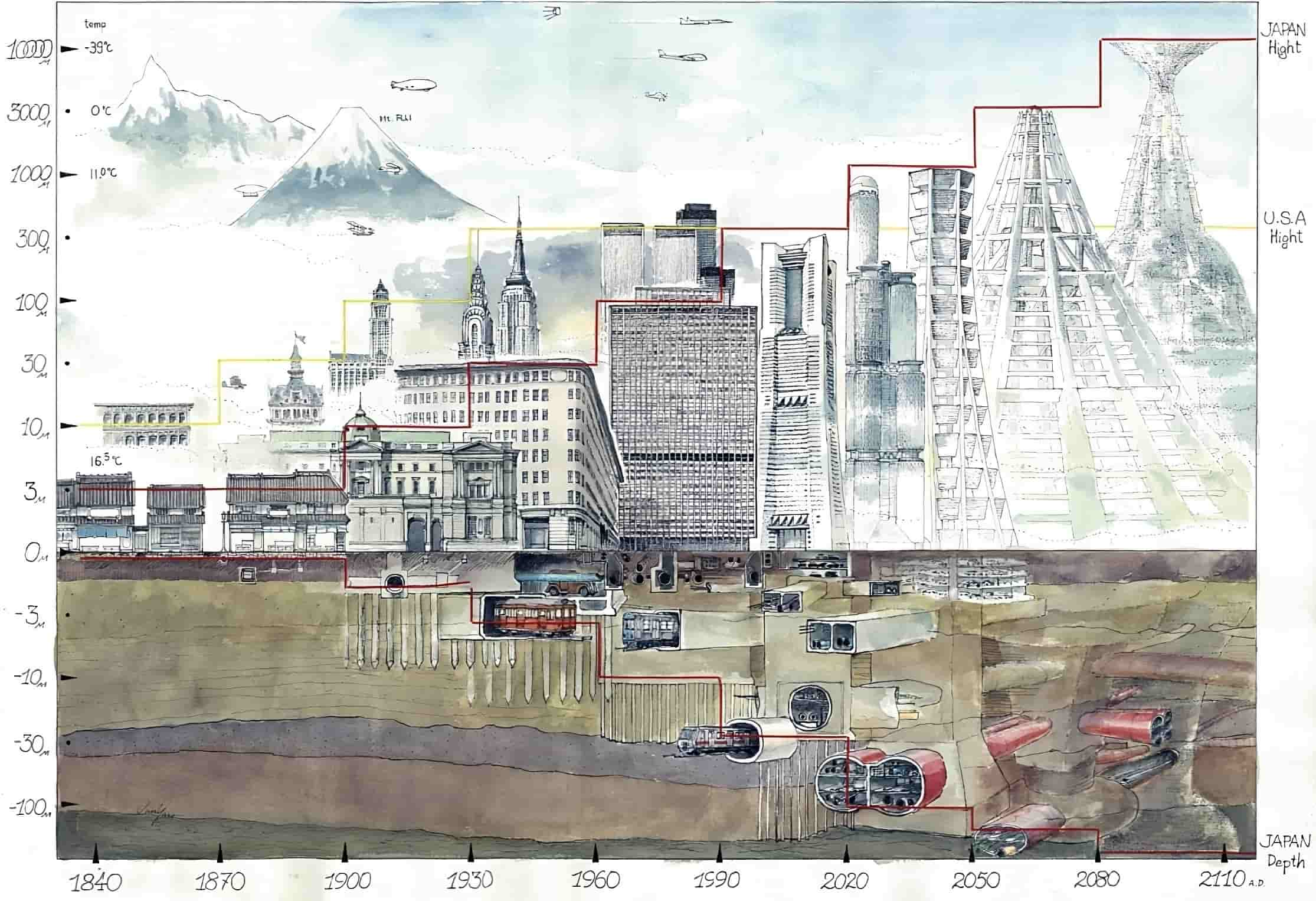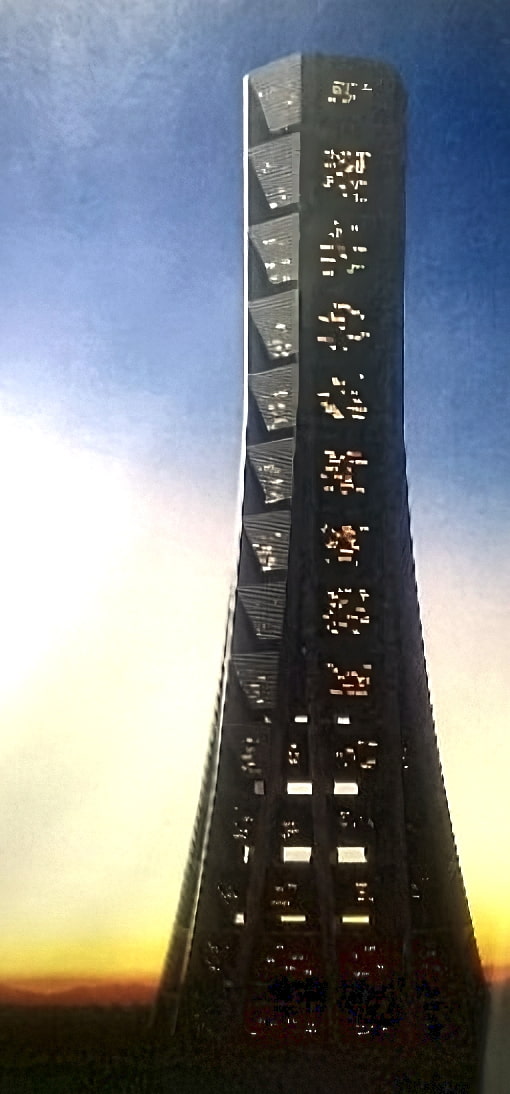The Sky City 1000 is a project to build a mega-skyscraper that is 1,000 meters (3,280 feet) tall. It was first proposed by Takenaka Corporation in 1989. The Sky City 1000 was formerly known as Tokyo’s Sky City, and if built, it would be among the world’s tallest structures and Tokyo’s tallest buildings. With a maximum capacity of 135,000 people, the Sky City 1000 measures 3,445 feet (1,050 meters) tall when its antenna/spire is included. This superstructure has 196 floors and an inner area of 5,300,000 ft2 (492,000 m2). It was featured on the Discovery Channel’s Extreme Engineering in 2003, alongside such projects as the Transatlantic Tunnel (2002), and on the BBC.
The Sky City 1000 in Numbers

The official plan says that the Sky City 1000 could have 35,000 permanent residents and jobs for 100,000 people. Also planned are a lot of shops, hotels, schools, parks, sports fields, offices, and halls inside the city. They will transform the tower into a fully functional metropolis with a floor area of 3 square miles (8 km2).
The Sky City 1000 has six massive columns rising from its base. Between the columns are 14 platforms stacked on top of one another in the form of slabs. They are called “Space Plateaus.” The space on each platform is the size of a stadium. The base platform is the largest, and it measures 1,640 by 1,640 feet (400 by 400 m), while the top platform is 525 feet (160 m) in length. Each Space Plateau will have its own train circumnavigating it.

200,000 tons of steel are required for each of these six columns (for scale, the world’s biggest dump truck can carry up to a 450-ton load). This means a cost of $250 million for each column alone. And the whole Sky City 1000 would cost billions to build.
The Sky City 1000 will be based on a skeleton frame construction. These columns will be the only structural supports for the building, including no interior supports. The structure’s overall mass is around 5.5 million tons, which is roughly the same as the total human biomass of Japan’s population.
The Sky City 1000’s overall size is 2,000 acres (800 hectares), of which 590 acres (240 hectares) would be used for parks and roadways. If construction were to begin, the Takenaka Corporation believes that they would begin settling people as the building rose to the sky. After the construction of a platform is completed and the work on the next platform begins, new people would be able to move into their residences.
The Sky City 1000’s Purpose of Building

The Sky City 1000 is one of the extremely tall visionary buildings conceived during the Japanese economic bubble. Like them, it is an arcology (“architecture” and “ecology”) project. But unlike those projects, the Sky City 1000 was not conceived as a means to advertise an architectural firm. The primary motivation behind Sky City 1000 is the need to create more living space in Tokyo, which is home to over 14 million people today.
Transforming buildings into complete, self-contained city cells will help overcome traffic jams and crowded residents. According to the Takenaka engineers and other experts, this will save city dwellers a significant amount of time each day. This is in light of the average commute time of Tokyo residents today, which is between 2 and 4 hours. This adds up to 6 years over a lifetime.
The visionary grand plan developed by the engineers envisions a future for Tokyo in which groups (possibly three) of adjacent Sky City 1000s are linked together to form sky-high clusters, or “Heavenly Cities.” The project takes inspiration from Frank Lloyd Wright’s 1957 proposal for the “Illinois Tower.” He was an architect of the Chicago School and expert in high technology.
One building that suggests the feasibility of the Sky City 1000 project is Roppongi Hills. Roppongi Hills, built for $4.5 billion by building tycoon Minoru Mori in 2003, is Tokyo’s first tower city, housing 2,000 people. But the Sky City 1000 as an endeavor appears to be more committed and expansive based on its features.
The Safety of Living in a 3,300-Foot Building

Due to their astounding height, mega-tall buildings like this are especially susceptible to severe weather tremors. The design requirements for wind in a mega-tall building like the Sky City 1000 exceed those for earthquakes. This is valid even in extremely active areas such as Japan.
This is because the sideways pressure from the wind on a mega-tall skyscraper is greater than the perpendicular weight on its floors. The Sky City 1000 addresses this issue by placing air vents in key locations, which enable air to flow through instead of pushing the building.
Priority has been given to ensuring the safety of those who will live within Sky City 1000. In addition to strong winds, possible fires also pose a threat to those inside.
Each of the 14 platforms of the building will have a fireproof base and walls. Additionally, there are a minimum of six fire-resistant zones on each block platform. In the event of a fire, specially equipped fire helicopters will be dispatched to the scene. The only firefighting helicopter in Tokyo was even put through its paces during exercises designed to simulate the challenges of battling a fire in a building of this height.
The fire helicopters will be equipped with a long-range water gun and a 265-gallon (1,000 lt) water reservoir. The reservoir will be refilled from the pool or elsewhere on the premises.
To better counteract the fires, the high-speed lifts with three-deckers were even prototyped in facilities outside of Tokyo for the Sky City 1000.
The Design Features of the Sky City 1000

The perfect base for Sky City 1000 was developed through a succession of prototypes and experiments by scientists at the Takenaka Corporation. The building was initially fortified by being buried deep underground. But due to the unusual nature of the earth in Tokyo, the length of the Sky City 1000’s substructure would need to be double its height above ground! The plan was to pour concrete into a network of deep pipelines dug into the ground at various depths. So, this could serve as a solid foundation for the structure above.
Testing with scale models revealed that even a moderate wind gust would cause the 3,300-foot (1,000 m) building to tremble. This was adding another threat to the structure. Therefore, it was determined to first round the building’s outline and then create empty space between the platforms to reduce the wind’s resistance. Each of these open spaces is the size of a stadium.
The wobble caused by the wind could, in theory, be mitigated by placing a pendulum counterbalance on the building’s middle floor. But given the size and mass of the building, this would not have been possible since the device would weigh 27,000 tons.
So, the engineers who worked on Sky City 1000 decided to use a special hydraulic motor to make this counterbalance work. This new approach drastically reduced the apparatus’s mass by tens of times. They also intended to install special rubber dividers between the floors to lessen the building’s bending during typhoons.
The Innovative Aspects of the Sky City 1000 Project

Masato Ujigawa, head of Takenaka’s engineering department, explains, “The feature of our proposal was making artificial land in the air.” Sky City 1000’s concepts have since found their way into more traditional building practices. Some examples are self-contained water-service systems in structures that process waste and reuse water, and concrete strengthened with carbon fibers rather than iron to reduce weight.
The innovations behind the Sky City 1000 project’s engineering and ideas:
- A unique architectural style resembling a skeleton.
- There would be enough room for 100,000 people in the Sky City 1000 during rush hour. The building accommodates trains and the three-story lifts which each have their own automated engines. Those lifts can travel at rates of more than 55 miles per hour (90 km/h).
- The project would utilize the one-of-a-kind “Big Crown” construction robots. They are self-raising construction platforms with four hydraulic lifts. And they are designed to progressively elevate themselves as the Sky City 1000 is built.
- Massive, automated gantry cranes would also be utilized during the construction. They would place the blocks autonomously in their correct spots in the blueprints by scanning a unique identifier on each block.
Transportation
In the blueprint of the Sky City 1000, there are a total of three different routes one can take to get around the building. The first option is to ride a high-speed lift that can travel both vertically and horizontally and can hold up to 70 people at a time. Sky City 1000 commuters can also travel from the ground floor to the top floor via separate trains. Finally, the third option of transportation is the “Air Wagons.”
Challenges in Building the Sky City 1000

If built, the Sky City 1000 would be as heavy as all of Japan’s inhabitants combined. It would also be much taller than the tallest structure ever in Japan, the Tokyo Skytree (2080 ft; 634 m). Those aspects alone present their own set of challenges.
Massive steel slabs, for example, had to be bonded together to form the six massive columns. That’s actually enough steel to construct 36 aircraft carriers. For instance, the American navy has 11 aircraft carriers today. And it would take the typical steel mill 12 years to produce that much steel.
Shipments from companies all over the globe would be anticipated to hasten the construction process. But that would still not be enough, and one completely autonomous plant would need to be built nearby the construction site of the Sky City 1000.
Will the Sky City 1000 Ever be Built?
Today, there is more interest in mega-tall structures like the Sky City 1000 than ever before. But the project is still seen as a challenging construct in the near future, along the lines of the Tokyo Tower of Babel, the Shimizu Mega-City Pyramid, the Ultima Tower, and the X-Seed 4000. The officials at the business, however, still claim that they will begin the construction of Sky City 1000 within the next two decades. Since Japan’s population started declining in 2005, construction on Sky City 1000 has not begun. If Sky City 1000 were ever to be built, it would stand as the tallest building ever constructed by humans.
Trivia: In Auckland (New Zealand) there is a 1,076-foot (328-meter) high “Sky Tower” as part of an entertainment complex also called “Sky City”.





